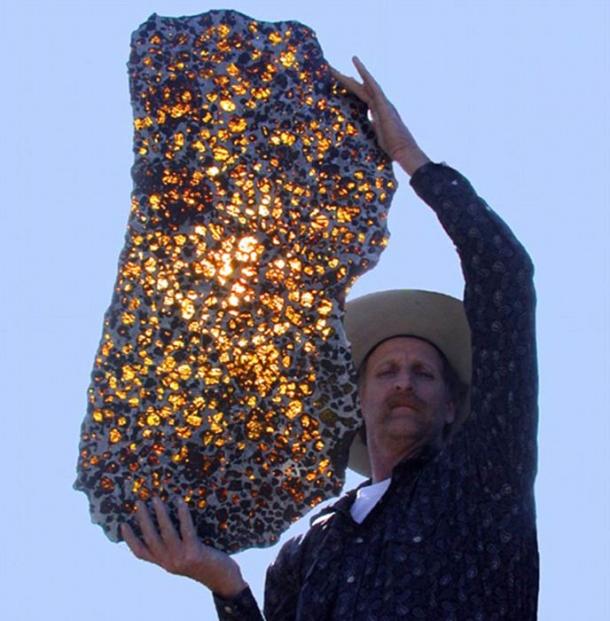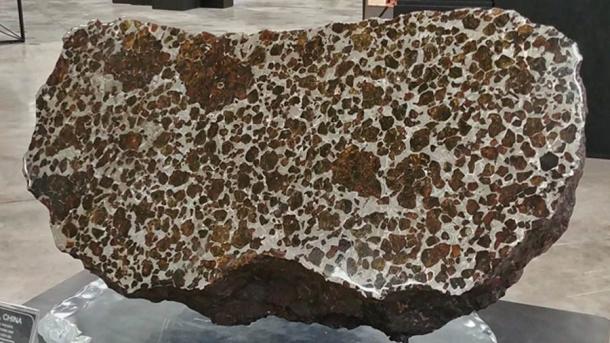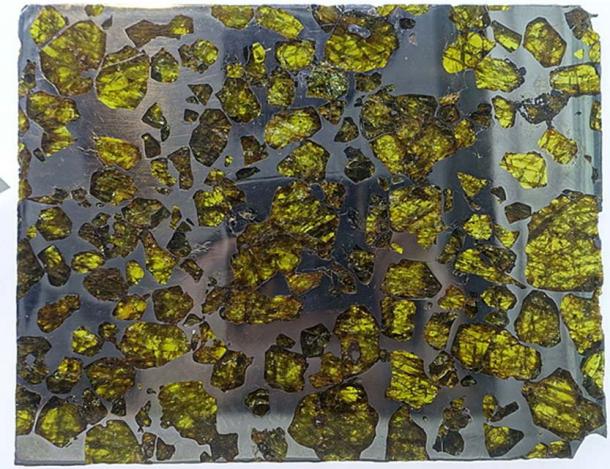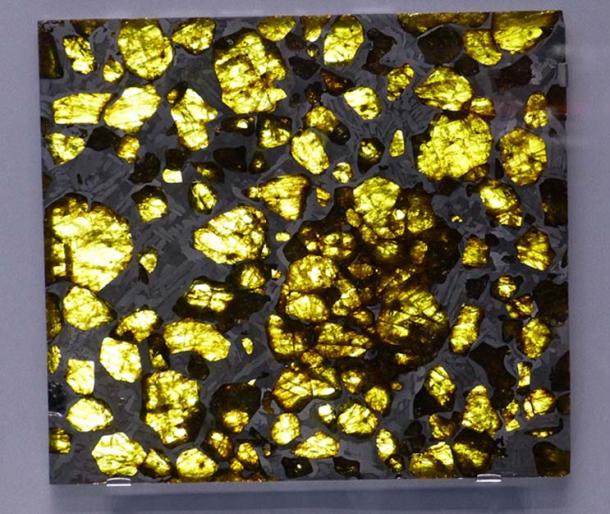
Space Rock Mystery: Where Did the Fukang Meteorite Come From?
The Fukang Meteorite is the name given to a meteorite that was discovered in China. The Fukang Meteorite belongs to a class of stony-iron meteorite known as Pallasite, which may be recognized by the fragments of olivine crystals embedded in an iron-nickel matrix. According to one source, the stunning slices of such a meteorite, when illuminated from the back, are “reminiscent of stained glass windows crafted in the ancient solar system.”
Was the Fukang Meteorite Up For Sale?
Part of the Fukang Meteorite was recently sold at auction. In February 2021 Christie’s reports that it sold an “end wedge of the most beautiful extraterrestrial substance known.” Just that portion of the meteorite alone fetched a whopping 30,000 USD for the seller – well over the 3,500-4,500 USD estimate. So what makes the Fukang Meteorite so special?
For one thing, it’s not a “common meteorite.” Pallasites are an extremely rare type of meteorite. This is due to the fact that most Pallasites do not survive their descent through the Earth’s atmosphere. It has been estimated that less than 1 % of all meteorites are Pallasites. Therefore, the Fukang Meteorite has often been hailed as one of the greatest meteorite discoveries of the 21st century.

Out of this world, quite literally: The beautiful and mysterious Fukang meteorite. (Katexic Clippings Newsletter/CC BY 2.0)
Discovering the Meteorite
The Fukang Meteorite was discovered near the town of Fukang in Xinjiang, an autonomous region in the northwestern part of China. The meteorite was discovered in 2000 by an anonymous hiker. This hiker is said to have often stopped on a giant rock to have his lunch. He became curious about the type of rock, which seemed metallic and had crystals in it, that he had been resting on. The man decided to break some pieces of the rock off, and had them send to the United States, where it was confirmed that the sample he had sent was from a meteorite.
- Falling Stars and Black Stone: Humanity’s Worship of Meteorites
- People of the Arctic worked meteorite iron 1,200 years ago

This is the main mass of the Fukang meteorite, on display in the Michael J. Drake building at the University of Arizona in Tucson. Note the large olivine nodules. (Nicholas Silvestri/CC BY-SA 4.0)
In February 2005, this specimen made an appearance at the Tucson Gem and Mineral Show, where it was seen by D. S. Lauretta, a Professor of Planetary Science and Cosmochemistry at the University of Arizona (and also the principal investigator of NASA’s OSIRIS-REx mission). Subsequently, the rest of the Fukang Meteorite (which has a mass of 983 kg (2167 lbs.), excluding the 20 kg (44 lbs.) removed by the anonymous hiker) was studied by the University of Arizona.

Fukang meteorite slice, pallasite. Exhibit at the Center for Meteorite Studies, Arizona State University, Tempe, Arizona, USA. (Public Domain)
The Fukang Meteorite was found to be of a type of stony-iron meteorite known as Pallasite. Stony-iron meteorites are meteorites that are made up of meteoric iron and silicates in an almost equal proportion. Pallasites may be distinguished by a matrix of meteoric iron, in which silicates, mostly olivine (which is a type of yellow to yellowish-green crystal), are embedded. This type of meteorite, incidentally, is named after Simon Peter Pallas, a German doctor and naturalist who first described the Krasnojarsk Pallasite in Russia in 1772.
Unknown Origins
The exact origins of the Fukang Meteorite, as well as other Pallasites are not entirely clear. Nevertheless, it has been speculated that they originated from the boundary of a melted and differentiated asteroid and its surrounding olivine mantle. The Fukang Meteorite is thought to have been formed at the birth of the solar system approximately 4.5 billion years ago, when the olivine fragments from its mantle mixed with the molten metal from its core upon impact on earth.
Unrivaled Beauty
Apart from its rarity, the Fukang Meteorite, like other Pallasites, is a very beautiful object to behold. When light is shone on slices of the Fukang Meteorite, it passes through the olivine crystals, giving the meteorite a breath-taking glow.

Natural History Museum, Vienna. Part of a pallasite meteorite from Fukang (CC BY-SA 3.0)
Due to this spectacular beauty, there has been a demand amongst collectors for slices of the Fukang Meteorite. The largest chunk of this meteorite, which weighs 419.5 kg (924.8 lbs.), is currently held by an anonymous collector / group of collectors. In 2008, an attempt was made to sell this portion of the Fukang Meteorite at an auction in Bonham’s in New York for about 2 million USD.
- Why did Tutankhamun Have a Dagger Made From a Meteorite?
- Ancient Signs in the Sky: Did a Meteorite Change the Course of Christianity 2,000 Years Ago?
The object, however, did not receive any bidders. Other smaller slices of the meteorite, such as the aforementioned end wedge, have been sold at auctions and have been distributed around the world. The University of Arizona’s Southwest Meteorite Laboratory, for example, has a total of 31 kg (68 lbs.) of the Fukang Meteorite in its deposit.
Top image: Pallasite (Fukang Meteorite) Source: CC BY 2.0
By Wu Mingren
Updated on May 14, 2021.
References
Brennan, L., 2012. Out of this world, quite literally: The beautiful and mysterious Fukang meteorite. [Online]
Available at: http://www.dailymail.co.uk/sciencetech/article-2129747/The-beautiful-mysterious-Fukang-pallasite-meteorite.html
Kaushik, 2013. The Beautiful Fukang Meteorite. [Online]
Available at: http://www.amusingplanet.com/2013/05/the-beautiful-fukang-meteorite.html
Notkin, G., 2017. Stony-Iron Meteorites. [Online]
Available at: http://geology.com/meteorites/stony-iron-meteorites.shtml
Scott, E., 2010. Formation of Stony-Iron Meteorites in Early Giant Impacts. [Online]
Available at: http://www.psrd.hawaii.edu/June10/pallasites-origin.html
Southwest Meteorite Laboratory, 2017. The Fukang Pallasite. [Online]
Available at: http://www.meteoritelab.com/collection/fukang.php
Svyatnyk, 2016. The 4.5 Billion Year Old Fukang Meteorite. [Online]
Available at: https://mysteriousearth.net/2016/10/17/the-4-5-billion-year-old-fukang-meteorite/
The Meteorite Exchange, Inc., 2017. Fukang Meteorite. [Online]
Available at: http://www.meteorite.com/fukang-meteorite/
The Meteoritical Society, 2017. Fukang. [Online]
Available at: https://www.lpi.usra.edu/meteor/metbull.php?code=34491
















Comments
Nice rebuttal, lol. You win.
Just because I speak the truth doesn't make me a hater
That's a great question! I really wanted to know the answer so I dove down the rabbithole and actually read the article (I know, I'm crazy).
It says the meteor was discovered by a hiker, not america. Eventually the hiker decided to try and find out what kind of rock it was, and arranged to have samples sent to the U.S. to be identified. So it does not seem to have been "stolen by america as usual".
I guess you could say it was "stolen" from the Chinese government, since in communism there is no such thing as private property, everything is the "property of the proletariat". But this looks like the theft was perpetrated by a member of the proletariat (the hiker). He probably sent it to the U.S. because he knew they would test it properly and they would not steal it from him.
Meanwhile, I'm sure the Chinese government will survive the loss. After all, they steal tens of billions of dollars worth of industrial secrets from U.S. private citizens and businesses every year.
I wonder did they have proper permission from the Chinese Government to remove any of it or was just america as usual and just robbed it